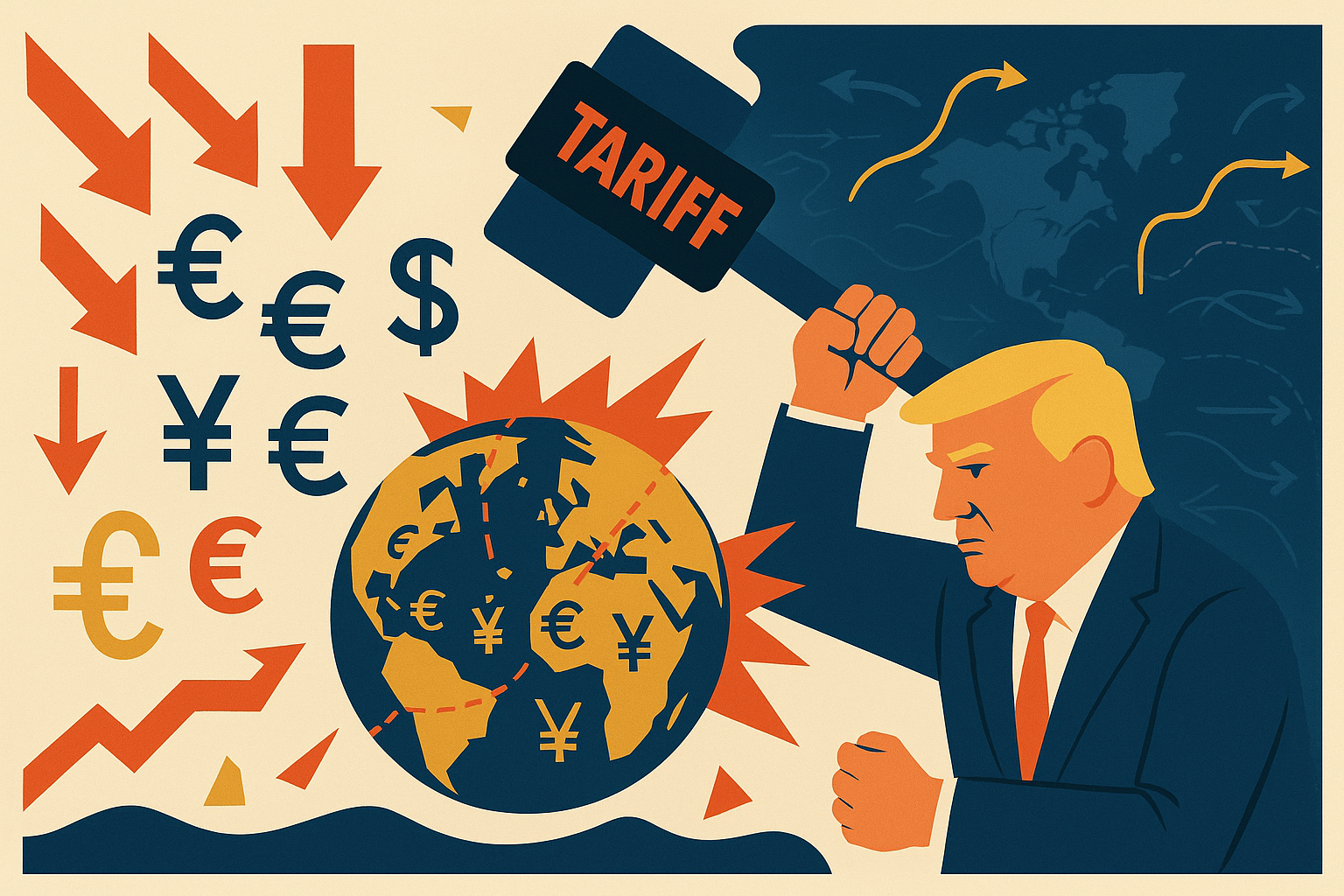August 1st: The Day the World Trembled as Trump’s “Snapback Tariffs” Herald a New Era
A Bolt from the Blue That Shook the Globe
On the morning of August 1st, before global financial markets had even opened, news broke that struck like a thunderbolt. President Donald Trump had announced the implementation of massive tariff measures targeting 69 countries and territories. The announcement sent shockwaves through the New York Stock Exchange, with the Dow Jones Industrial Average plummeting 542 points and the tech-heavy Nasdaq Composite Index suffering a devastating 2.24% decline.
What we are witnessing is not merely an adjustment in trade policy. This represents a fundamental break from the free trade system that has prevailed for over 70 years since World War II—a historic moment that signals the dawn of a new protectionist era.
“Snapback Tariffs”: An Economic Weapon by Any Other Name
Treasury Secretary Scott Bessent characterized these measures as “snapback tariffs,” a term that carries the implicit meaning of a “return” to the high tariff rates announced on April 2nd. While Bessent offered an optimistic view, suggesting it wouldn’t be “the end of the world if these snapback tariffs are on for anywhere from a few days to a few weeks,” his words did little to reassure business leaders and investors worldwide.
President Trump himself left no room for compromise regarding the August 1st deadline. His declaration on Truth Social—”THE AUGUST FIRST DEADLINE IS THE AUGUST FIRST DEADLINE — IT STANDS STRONG, AND WILL NOT BE EXTENDED. A BIG DAY FOR AMERICA!!!”—carried the weight of an ultimatum.
The Logic Behind Country-Specific “Penalties”
The tariff rates announced reveal the Trump administration’s distinctive worldview. The highest rate of 41% was imposed on war-torn Syria, while Laos and Myanmar face a crushing 40% burden. In contrast, the European Union and Japan, having secured concessions through negotiations, achieved relatively “favorable” rates of 15%.
Particularly intriguing is the 39% tariff rate imposed on Switzerland. Why a neutral nation known for its diplomatic stance should face such harsh measures remains unclear. The tariff rates for various countries cannot be explained solely through economic logic but appear to be determined by complex factors that transcend traditional trade considerations.
India’s 25% tariff comes with a political message—a “penalty” for purchasing military equipment and energy from Russia. This vividly demonstrates how economic policy has become inextricably linked with foreign policy objectives.
European Market Turmoil and Corporate Impact
Beyond American stock markets, major European indices also tumbled. Germany’s DAX index fell 2.66%, France’s CAC 40 dropped 2.91%, marking the worst single day since April. This illustrates how tariff impacts extend far beyond American borders to ripple through the entire global economy.
The alcohol industry faces particularly severe consequences. French wines, Scottish whisky, and Dutch gin—beverages that countless Americans have enjoyed—now face a 15% tariff. The cost of enjoying a glass of wine during Friday night happy hour is set to rise definitively.
Nations Grapple with Agonizing Responses
Chinese Foreign Ministry spokesman Guo Jiakun’s statement that “there is no winner in a tariff war or trade war” perfectly encapsulates the current international climate. China faces an agreement deadline of August 12th, and the U.S.-China trade talks in Stockholm concluded without achieving decisive results.
Meanwhile, the Indian government maintains the diplomatic facade of “remaining focused on the substantive agenda that our two countries have committed to,” while privately agonizing over the 25% tariff rate and the “penalty” for Russian transactions. For India, America represents its largest export market, and these tariff measures could deal a severe blow to the country’s economy.
Japanese Prime Minister Shigeru Ishiba continues to seek swift implementation of agreements including tariff reductions on automotive products, but the Bank of Japan has already warned of declining profits for Japanese firms and downward revisions to capital expenditure plans. Despite securing a “preferential” 15% rate through negotiations, the impact is far from negligible.
Legal Battles and Political Chaos
Legal disputes surrounding these tariff policies are intensifying. The U.S. Court of International Trade ruled in May that tariff measures based on the International Emergency Economic Powers Act are illegal, though tariffs continue during the appeal process. One judge questioned, “Can the trade deficit be an extraordinary and unusual threat when we have had trade deficits for decades?”
Politically, Trump’s methods face fierce criticism. The dismissal of the Bureau of Labor Statistics commissioner following disappointing monthly employment figures drew sharp condemnation from Senate Democratic Leader Chuck Schumer, who called it “dictator-like behavior.” His characterization of the administration as “shooting the messenger instead of trying to fix the economy” succinctly captures the current administration’s approach.
A Turning Point Toward a New World Order
According to Tax Foundation analysis, these tariff measures will impose an additional burden of $1,219 per American household in 2025, rising to $1,453 in 2026. This represents the largest tax increase since 1993—truly historic in scale.
However, these figures represent more than mere economic burden increases. From January to April, America’s average applied tariff rate skyrocketed from 2.5% to 27%, reaching the highest level in over a century. This signals the end of an era when globalization was taken for granted.
An Era Demanding Fundamental Business Strategy Overhauls
Many American companies have previously absorbed tariff costs internally to avoid passing price increases to consumers. However, as the scale and scope of tariffs continue expanding, this strategy is no longer sustainable. Considering that over 90% of American importers are small businesses, these impacts will be widespread.
Overhauling business models premised on global supply chains is no longer optional but inevitable. The traditional strategy of manufacturing products in countries with cheaper labor costs and importing them to America faces major revisions in light of the new reality of high tariffs.
August’s New Reality
As Treasury Secretary Bessent noted, “I would expect that it’s going to be a busy August,” making this month crucial for negotiations for many countries. The one-week grace period until August 7th represents a final opportunity for nations. For countries scheduled to face tariffs of 15% or higher, reaching some form of agreement during this period is a matter of survival.
Yet this situation transcends mere short-term negotiation tactics. Trump’s tariff policy represents a fundamental challenge to the multilateral free trade system that forms the backbone of the postwar international order. The shift from multilateral negotiations centered on the WTO to bilateral negotiations where America can exercise overwhelming power will fundamentally alter global economic dynamics.
What we are witnessing is the dawn of a new protectionist era. The consequences of this transformation cannot be measured by tariff rate percentages alone. It means reconsidering all the benefits of globalization we have taken for granted—from inexpensive imported goods to diverse consumer choices.
August 1st will undoubtedly be recorded as a pivotal turning point in world trade history. The new chapter that began on this day will determine the shape of the global economy for decades to come.
News Sources:
- CNN Business: https://www.cnn.com/business/live-news/trade-deadline-tariffs-trump-deals
- Al Jazeera: https://www.aljazeera.com/news/2025/8/1/trump-sets-new-tariffs-on-dozens-of-countries-exports
- CNBC: https://www.cnbc.com/2025/07/30/trump-trade-august-tariff-deadline.html
- White House: https://www.whitehouse.gov/presidential-actions/2025/07/further-modifying-the-reciprocal-tariff-rates/
- Tax Foundation: https://taxfoundation.org/research/all/federal/trump-tariffs-trade-war/
- GlobalSecurity.org: https://www.globalsecurity.org/military/library/news/2025/08/mil-250801-pdo03.htm
- CBS News: https://www.cbsnews.com/news/trump-trade-deals-tariffis-deadline/


